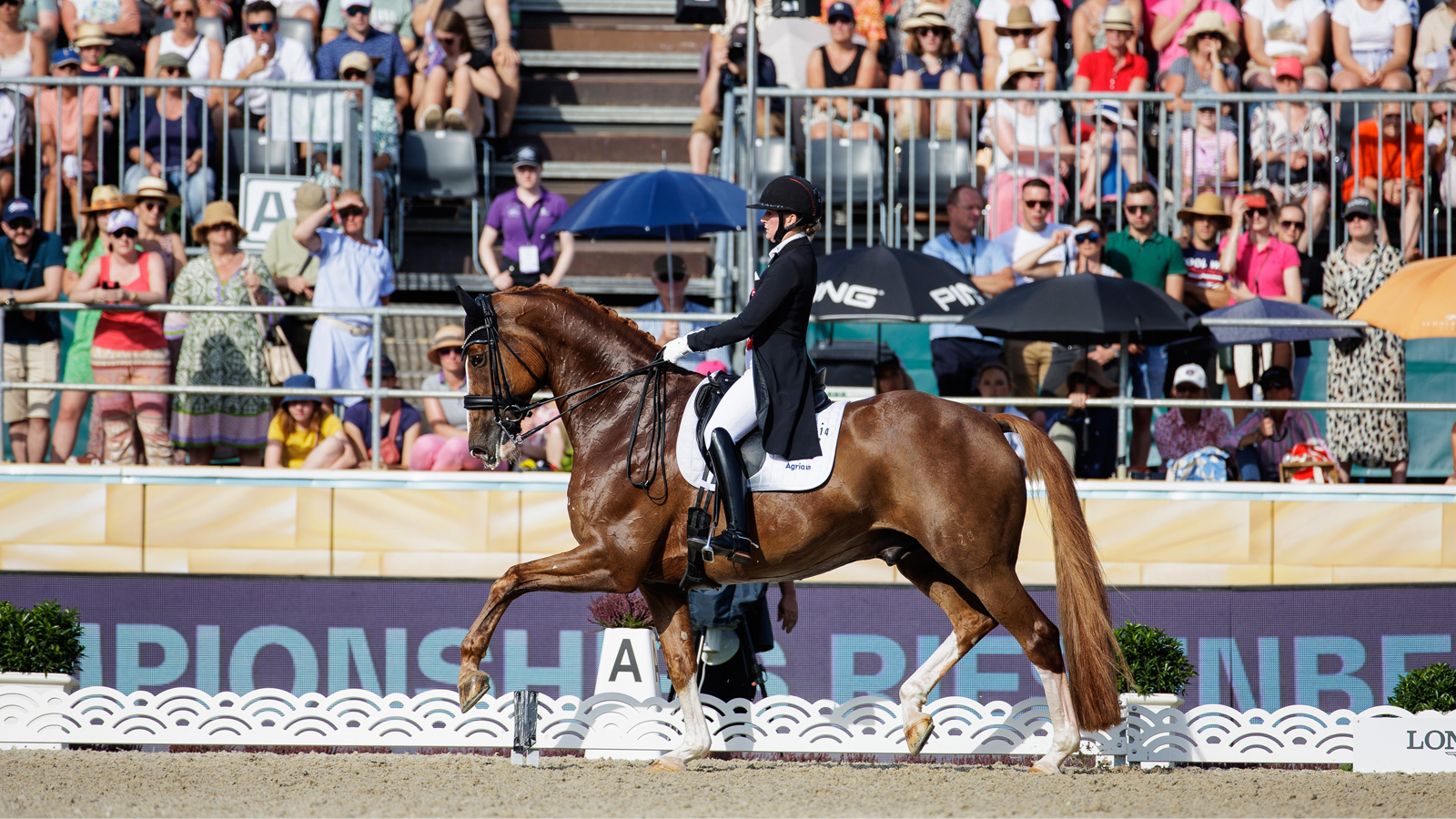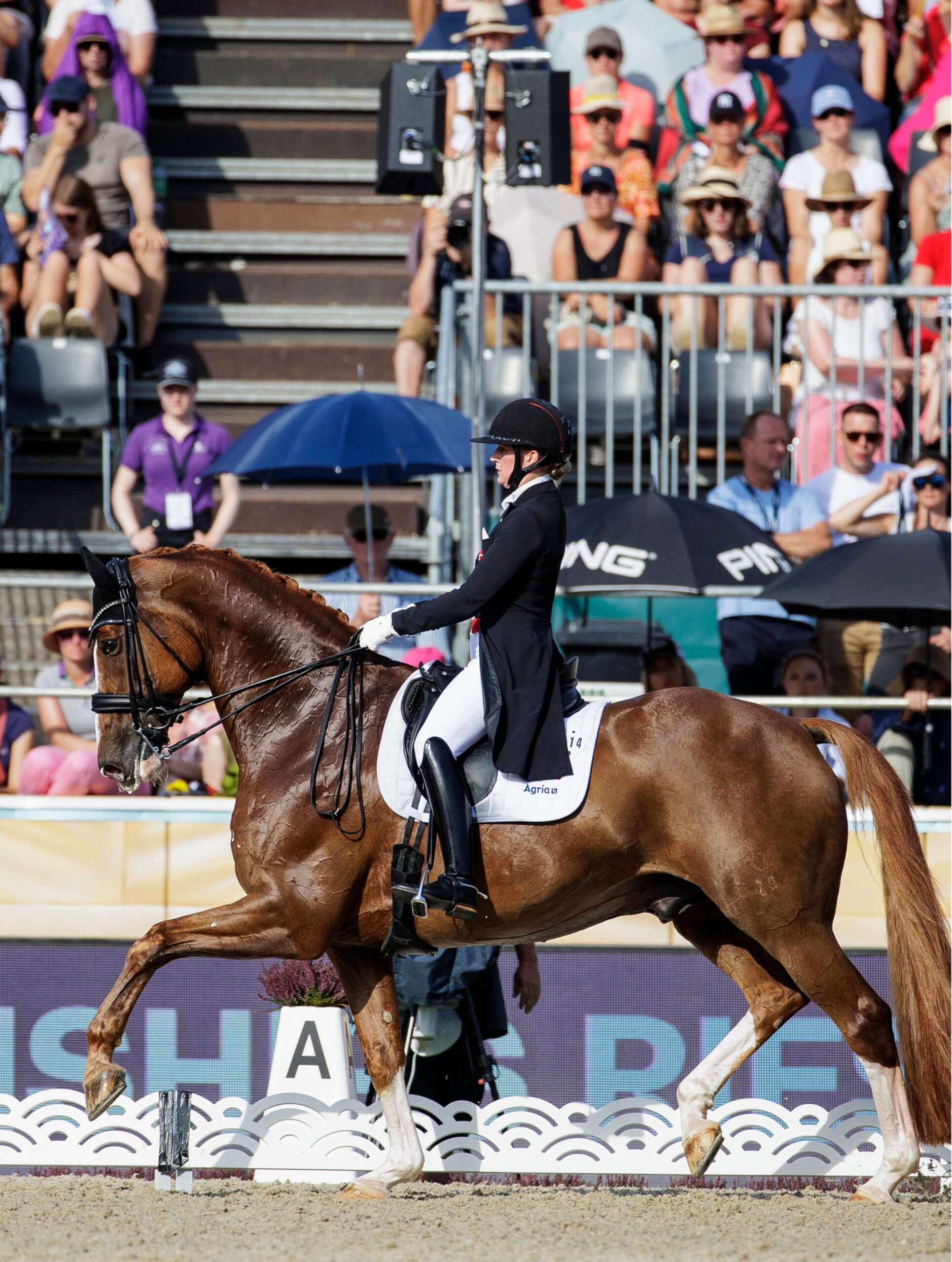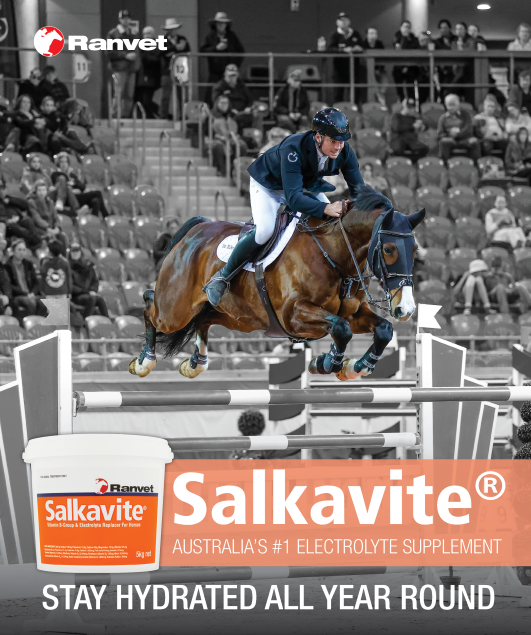Dressage riders are preparing for the Australian Championships this month. This is the second opportunity for qualifying for the Paris Olympics for able-bodied riders and the first for para riders to qualify for the Paris Paralympics. So, every mark counts.
We are practising all the sand dancing moves, doing our preparation. Remember the adage PPPPP (Perfect Preparation Prevents Piss Poor Performance). We are preparing. We practise all our sand dancing moves; the laterals, the transitions, the fancy pants higher collection. Preparation is important at home, but it is also important to prepare each movement within the test.

Kerry Mack has been practising all the sand dancing moves at home with Kingsley, who will contest the Novice and Elementary classes at the upcoming Australian Dressage Championships. Image by Roger Fitzhardinge.
The corners will correspond to a quarter of a circle with a diameter 2m smaller than the smallest circle in the test. So, in Preliminary it is a quarter of an 18m circle and at trot 8m in all other EA tests, and a quarter of a 6m circle at FEI levels. Each corner should be six strides. You can count the strides from the beginning of the bending. The third and fourth stride will be right in the corner and the sixth stride is the last stride with bend before straightness is re-established. At every level the corner can be six strides because as the horse gets more collected the stride is shorter, so the six-stride guide still applies.
So, before you get to the corner, a half-halt or two to rebalance the horse and PREPARE. I think of the half-halt as THREE little aids in quick succession. Balance (gently apply rein and core muscles), push (leg), soften (hand and core). Balance, push, soften, like a ripple of aids that runs through the body of the horse to rebalance and re-energise, and assist him to be in self-carriage. Then your six strides. Then straight, two legs into two hands – think train tracks. Before you arrive at the corner, another half-halt to balance and prepare.
The inside leg is like the post that your horse bends around and stops him from dropping his shoulder to the inside. Think about keeping his shoulder up and his body vertical, not leaning. It will help if you do this with your body too. Stay vertical, don’t lean into the corner. See if you can soften the inside rein and encourage him to reach towards it in the corner. This helps him to soften.
In training you can practise riding the corner sometimes pushing the quarters in like travers, sometimes bringing the shoulders in, sometimes even riding a renvers through the corner just to see if you can. When you are riding the test, you may need these reactions to ride the corner correctly, so practise the corrections at home. Horses will often have a tendency to let the quarters drift out in the corner so as to avoid carrying weight. A rider who only uses the inside rein to steer around the corner can inadvertently pull the shoulder to the inside, allowing the quarters to drift out. Riding the corner thinking about the outside rein holding the shoulder to the outside can help counteract this and help you develop the correct feeling of inside leg to outside rein that is so important in developing suppleness and self-carriage.

The short side is where the judges at C, H and M get the best view of your horse. Image by FEI – Massimo Argenziano.
With a young horse, however, there may be times that you want to encourage the suppleness by allowing the outside hand forward, encouraging him to stretch the outside to bend the neck. It is always true that there is never one right way to do things, and in training you may need to mix it up. Sometimes you want to train to do something, like giving the outside rein or riding a stretchy corner, just to know that you can, that your horse has the suppleness and balance to be obedient to an unusual question. You may not want a stretchy corner in the test, but you want to be able to do it if you ask.
When you ride the straight part, allow him to come up a little if you want him higher in the frame. I choose the word “allow” carefully. Don’t jack his head up with the reins; allow him a little forwards. If you need more impulsion, get it here. If you need more collection, the straight part is an opportunity to encourage him to wait and rebalance. Slow down on the short side if that is what you need. The straight part of the short side is an opportunity for the rider to pay attention to the pace and notice if you need more energy or more collection. The judges can notice the quality of the pace on the short side and so can the rider. Show him off on the short side.

When you ride the straight part you can allow the horse forward to come up a little if you want them higher in the frame. Image by Andrew Ryback – FEI.
Sometimes the straight part can be ridden with little shoulder-fore. This is really useful especially at walk if your horse has a tendency to lose the rhythm of walk either because the walk is weak or because he is anticipating the next transition and is a little tense.
Repetition trains. The arena has four corners that are an opportunity to practise the corner. You can practise riding corners by riding a square, or riding a modified serpentine where you go across the arena from marker to marker with square corners. Remember to practise the short side in all three paces.
So, I think that you can see that riding a corner is not a rest but is actually very busy and active. Use the short side to remember what you are doing next and prepare for it. There are no actual marks for the short side, but I hope this little article can help you see how riding an excellent short side can really help your marks. EQ
YOU MIGHT ALSO LIKE TO READ BY KERRY MACK:
The Subtle Art of Suppleness – Equestrian Life, September 2023
Perfecting The Pirouettes – Equestrian Life, August 2023
Get In The Zone & Go With The Flow – Equestrian Life, July 2023
How to Resolve Common Problems – Equestrian Life, June 2023
A Smarter Way to Compete – Equestrian Life, May 2023
What Motivates Me – Equestrian Life, March 2023
More Than a Walk in the Park – Equestrian Life, February 2023
Scott Keach Makes His Own Luck – Equestrian Life, December 2022
No Room for Bullying in Our Sport – Equestrian Life, November 2022
Avoid the Mud (Play Indoors) – Equestrian Life, October 2022
Why We Love Our Sport – Equestrian Life, September 2022
Getting on the Bit – Equestrian Life, July 2022
Positive Training Really Clicks with Horses – Equestrian Life, June 2022
Learn From Your Mistakes – Equestrian Life, March 2022 issue
Young Horse Classes: A Fun Launching Pad – Equestrian Life, February 2022
Making Sense of all the Bits & Pieces – Equestrian Life, January 2022
The Secret to ‘Soft Hands‘ – Equestrian Life, December 2021
Ask Less, Reward More – Equestrian Life, October 2021
So You Want To Go To The Games? – Equestrian Life, September 2021
The Ins & Outs Of Bitless Bridles – Equestrian Life, July 2021
Taking The Plunge With The Lunge – Equestrian Life, June 2021
Dressage for Showjumpers – Equestrian Life, May 2021
23 Shoulder-In Exercises to Improve Your Horse – Equestrian Life, April 2021
Understanding Your Horse’s Inner Thoughts – Equestrian Life, March 2021
Make the Most of Your Seniority – Equestrian Life, February 2021
Building Better Relationships – Equestrian Life, January 2021
Whipping Up Controversy – Equestrian Life, December 2020
The Importance of a Trusting Relationship – Equestrian Life, November 2020
Welcome to Kindergarten for Foals – Equestrian Life, October 2020
The Carrot or the Liquorice? Positive Reinforcement – Equestrian Life, September 2020
Submission or Stress? Something to Chew On – Equestrian Life, August 2020
A Relaxed Horse is a Happy Horse – Equestrian Life, July 2020
The Literate Horse Rider – Equestrian Life, June 2020
Why Horses Love Ingrid Klimke – Equestrian Life, May 2020






